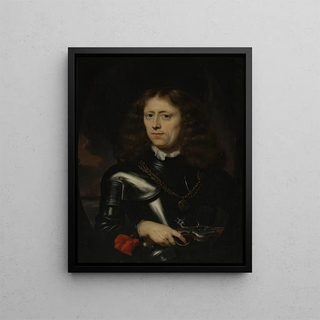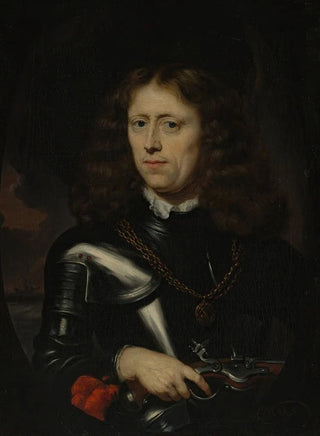Art print | Admiral Jacob Binkes - Nicolaes Maes


View from behind

Frame (optional)
The artwork "Admiral Jacob Binkes" by Nicolaes Maes is a masterpiece that immerses the viewer in the captivating world of 17th-century Dutch art. This painting, exemplifying the artist's technical virtuosity, reveals a scene imbued with dignity and gravity, where the central figure, Admiral Binkes, stands with remarkable confidence. The piece does not merely depict a man in uniform; it captures the very essence of power and authority, while also evoking a rare intimacy. The viewer's gaze is inevitably drawn to the depth of emotions that Maes manages to convey through the meticulous details of his work, making the visual experience profoundly immersive.
Style and uniqueness of the work
Nicolaes Maes' style is distinguished by its realistic approach and attention to detail. In "Admiral Jacob Binkes", every element, from the drapery of the clothing to the reflections of light on surfaces, is treated with precision that demonstrates the artist's skill. The colors, both rich and nuanced, create a vibrant atmosphere, while the subtle play of shadows enhances the three-dimensionality of the portrait. The composition, carefully balanced, highlights the imposing stature of the admiral while incorporating decorative elements that enrich the visual storytelling. This piece is not limited to a simple portrait; it is a true character study, where each look and gesture seem to tell a story—a story of bravery and loyalty.
The artist and his influence
Nicolaes Maes, a pupil of Rembrandt, established himself as a master in the artistic landscape of his time. His ability to combine the chiaroscuro characteristic of his mentor with a sensitivity unique to his style marked a turning point in portrait painting. Maes was able to capture not only the external appearance of his subjects but also their inner essence, a quality that is evident in "Admiral Jacob Binkes". His influence extends beyond his era, inspiring many artists who sought to explore the psychological depths of the characters they painted.

Matte finish

View from behind

Frame (optional)
The artwork "Admiral Jacob Binkes" by Nicolaes Maes is a masterpiece that immerses the viewer in the captivating world of 17th-century Dutch art. This painting, exemplifying the artist's technical virtuosity, reveals a scene imbued with dignity and gravity, where the central figure, Admiral Binkes, stands with remarkable confidence. The piece does not merely depict a man in uniform; it captures the very essence of power and authority, while also evoking a rare intimacy. The viewer's gaze is inevitably drawn to the depth of emotions that Maes manages to convey through the meticulous details of his work, making the visual experience profoundly immersive.
Style and uniqueness of the work
Nicolaes Maes' style is distinguished by its realistic approach and attention to detail. In "Admiral Jacob Binkes", every element, from the drapery of the clothing to the reflections of light on surfaces, is treated with precision that demonstrates the artist's skill. The colors, both rich and nuanced, create a vibrant atmosphere, while the subtle play of shadows enhances the three-dimensionality of the portrait. The composition, carefully balanced, highlights the imposing stature of the admiral while incorporating decorative elements that enrich the visual storytelling. This piece is not limited to a simple portrait; it is a true character study, where each look and gesture seem to tell a story—a story of bravery and loyalty.
The artist and his influence
Nicolaes Maes, a pupil of Rembrandt, established himself as a master in the artistic landscape of his time. His ability to combine the chiaroscuro characteristic of his mentor with a sensitivity unique to his style marked a turning point in portrait painting. Maes was able to capture not only the external appearance of his subjects but also their inner essence, a quality that is evident in "Admiral Jacob Binkes". His influence extends beyond his era, inspiring many artists who sought to explore the psychological depths of the characters they painted.






